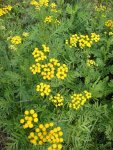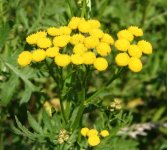Tansy
Tanacetum vulgare L.
Botanical characteristics.
Family Compositae. Perennial herbaceous plant with a solid straight stem, 60 - 125 cm high. It has a branchy rhizome. Leaves are regular, pinnately divided, dark and grayish-green in color. The whole plant produces a rather pleasant specific smell. Yellow tubular flowers on the tops of the stems are collected in baskets. Blossoms in June-August.
Leaves tansy can serve as a landmark on the terrain: located in the meridian plane - from north to south.
Spread. A widespread plant of the middle belt of the European part of the country, Siberia, Kazakhstan. It grows like a weed in vacant lots, along roads, in gardens and orchards, among thickets of shrubs, on the fringes of forests. In recent years, tansy has been cultivated as a spicy, food and medicinal plant.
Used parts of the plant.
Flower baskets collected at the beginning of flowering.
Tansy contains essential oil (up to 0.3%), consisting of? -tujone, i-camphor, borneol, pinene, a-thujone and tujola. In addition to essential oil, bitterness, tannins, flavonoids (luteolin and quercetin), organic acids, vitamin C (up to 8 mg%), traces of alkaloids and terpenes are found in the inflorescences.
Application.
It is used in folk medicine quite widely: with nervous disorders, epilepsy and migraines, with furunculosis and colds, with pulmonary tuberculosis; As choleretic in hepatocholecystitis and cholangitis.
Tansy is a good anthelmintic remedy (against ascarids and pinworms). Grass is also used as an insecticide to fight moths, fleas and flies.
Contraindications. Pregnancy. The plant is weakly toxic, it acts abortively.
Preparation. Infusion: 1 tablespoon of herbs are brewed in a half-liter thermos - a daily dose.





Comments
When commenting on, remember that the content and tone of your message can hurt the feelings of real people, show respect and tolerance to your interlocutors even if you do not share their opinion, your behavior in the conditions of freedom of expression and anonymity provided by the Internet, changes Not only virtual, but also the real world. All comments are hidden from the index, spam is controlled.